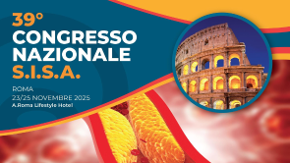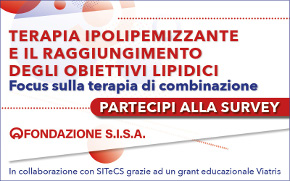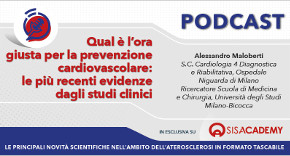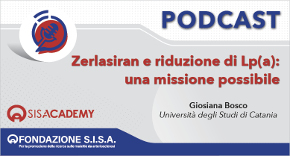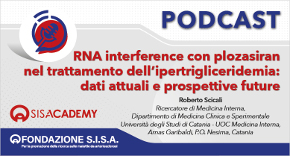 Rivista in lingua italiana
Rivista in lingua italiana
riservata ai Soci SISA
Ultimo numero:
Anno 16 • N.1/2025
SISANews
Gli omega-3 prevengono la fibrosi cardiaca
La presentazione riguarda due studi diversi ma che hanno in comune l'uso degli acidi grassi omega-3 nello scompenso cardiaco. Già il ben noto GISSI-HF aveva dimostrato l'effetto positivo degli omega-3, attribuendolo in larga misura all'azione antiaritmica. Sembra pero' che non sia tutto qui. I due studi pubblicati su JACC e Circulation dimostrano che l'azione degli omega-3 è molto più complessa e riguarda non solo l'elettrofisiologia, ma anche la capacità funzionale del cuore. Secondo l'articolo di Circulation, l'azione principale degli omega-3 è ascrivibile ad una marcata prevenzione della fibrosi cardiaca, causa principale di disfunzione diastolica. Dallo studio su JACC si evince che la somministrazione di omega-3, anche nelle fasi iniziali di scompenso cardiaco da cardiomiopatia dilatativa, migliora la funzione sistolica ed ha il rimarchevole effetto clinico di riduzione dell'ospedalizzazione per scompenso. Gli acidi grassi omega-e sembrerebbero dunque possedere, oltre all'azione di stabilizzazione di membrana, cui si attribuisce l'effetto antiaritmico, anche un'azione sul rimodellamento cardiaco.
![]()
Omega-3 fatty acids prevent pressure overload-induced cardiac fibrosis through activation of cyclic GMP/protein kinase G signaling in cardiac fibroblasts
Chen J, Shearer GC, Chen Q, Healy CL, Beyer AJ, Nareddy VB, Gerdes AM, Harris WS, O'Connell TD, Wang D.
Circulation 2011;123:584-93
BACKGROUND: Omega-3 polyunsaturated fatty acids (eicosapentaenoic acid and docosahexaenoic acid) from fish oil ameliorate cardiovascular diseases. However, little is known about the effects of ?-3 polyunsaturated fatty acids on cardiac fibrosis, a major cause of diastolic dysfunction and heart failure. The present study assessed the effects of ?-3 polyunsaturated fatty acids on cardiac fibrosis.
METHODS AND RESULTS: We assessed left ventricular fibrosis and pathology in mice subjected to transverse aortic constriction after the consumption of a fish oil or a control diet. In control mice, 4 weeks of transverse aortic constriction induced significant cardiac dysfunction, cardiac fibrosis, and cardiac fibroblast activation (proliferation and transformation into myofibroblasts). Dietary supplementation with fish oil prevented transverse aortic constriction-induced cardiac dysfunction and cardiac fibrosis and blocked cardiac fibroblast activation. In heart tissue, transverse aortic constriction increased active transforming growth factor-ß1 levels and phosphorylation of Smad2. In isolated adult mouse cardiac fibroblasts, transforming growth factor-ß1 induced cardiac fibroblast transformation, proliferation, and collagen synthesis. Eicosapentaenoic acid and docosahexaenoic acid increased cyclic GMP levels and blocked cardiac fibroblast transformation, proliferation, and collagen synthesis. Eicosapentaenoic acid and docosahexaenoic acid blocked phospho-Smad2/3 nuclear translocation. DT3, a protein kinase G inhibitor, blocked the antifibrotic effects of eicosapentaenoic acid and docosahexaenoic acid. Eicosapentaenoic acid and docosahexaenoic acid increased phosphorylated endothelial nitric oxide synthase and endothelial nitric oxide synthase protein levels and nitric oxide production.
CONCLUSION: Omega-3 fatty acids prevent cardiac fibrosis and cardiac dysfunction by blocking transforming growth factor-ß1-induced phospho-Smad2/3 nuclear translocation through activation of the cyclic GMP/protein kinase G pathway in cardiac fibroblasts.
![]()
Effects of n-3 polyunsaturated fatty acids on left ventricular function and functional capacity in patients with dilated cardiomyopathy
Nodari S, Triggiani M, Campia U, Manerba A, Milesi G, Cesana BM, Gheorghiade M, Dei Cas L.
J Am Coll Cardiol 2011;57:870-9
BACKGROUND: One hundred thirty-three patients with NICM and minimal symptoms on standard therapy were randomized to 2 g of n-3 PUFAs or placebo. LV function and functional capacity were assessed prospectively by echocardiography and cardiopulmonary exercise testing at baseline and at 12 months after randomization.
METHODS: Patients with chronic HF due to NICM and minimal symptoms while receiving evidence-based therapy were enrolled. LV function and functional capacity were assessed prospectively by echocardiography, cardiopulmonary exercise test, and New York Heart Association functional class at baseline and at 12 months after randomization to either 2 g of n-3 PUFAs or placebo.
RESULTS: At 12 months after randomization, the n-3 PUFAs group and the placebo group differed significantly (p <0.001) in regard to: 1) LV ejection fraction (increased by 10.4% and decreased by 5.0%, respectively); 2) peak VO(2) (increased by 6.2% and decreased by 4.5%, respectively); 3) exercise duration (increased by 7.5% and decreased by 4.8%, respectively); and 4) mean New York Heart Association functional class (decreased from 1.88 ± 0.33 to 1.61 ± 0.49 and increased from 1.83 ± 0.38 to 2.14 ± 0.65, respectively). The hospitalization rates for HF were 6% in the n-3 PUFAs and 30% in the placebo group (p = 0.0002).
CONCLUSIONS: In patients with NICM and minimal symptoms in response to evidence-based medical therapy, n-3 PUFAs treatment increases LV systolic function and functional capacity and may reduce hospitalizations for HF. Given these promising results, larger studies are in order to confirm our findings.
J Am Coll Cardiol 2011;57:870-9

Area Soci
Eventi
39° Congresso Nazionale
 39° Congresso Nazionale
39° Congresso NazionaleRoma, 23-25 novembre 2025
Save the date




 Spring Meeting Gruppi Giovani SID, SIGG, SIIA, SIMI, SIPREC, SISA
Spring Meeting Gruppi Giovani SID, SIGG, SIIA, SIMI, SIPREC, SISARimini, 6-8 aprile 2025
[continua a leggere]
 SISA LIPID ACADEMY - Corso avanzato di lipidologia clinica
SISA LIPID ACADEMY - Corso avanzato di lipidologia clinicaModena, 4-5 Luglio 2024
[continua a leggere]Giornale Italiano Arteriosclerosi
HoFH today
 Rivista Italiana della
Rivista Italiana della
Ipercolesterolemia
Familiare Omozigote
Anno 6 • N.1/2024
Rivista NMCD
Diateca
[continua a leggere]
[continua a leggere]
Newsletter
il vostro indirizzo di posta elettronica
Progetto LIPIGEN
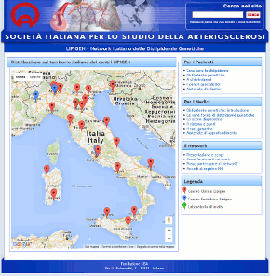
Nuovo sito dedicato al Progetto LIPIGEN
Progetto LIPIGEN - Vecchio portale
E' necessario essere loggati come utente
Lipigen per poter accedere alla pagina
PROject Statin Intolerance SISA
PROSISA – PROject Statin Intolerance SISA
E' necessario essere loggati come utente
PROSISA per poter accedere alla pagina
GILA - Lipoprotein Aferesi
Gruppo Interdisciplinare Lipoprotein Aferesi
(Accesso Gruppo GILA-Lipoprotein Aferesi)
E' necessario essere loggati come utente del Gruppo GILA per poter accedere
Gruppo Interdisciplinare Lipoprotein Aferesi
(Documentazione ad accesso libero)
Pagina informativa per medici e pazienti


